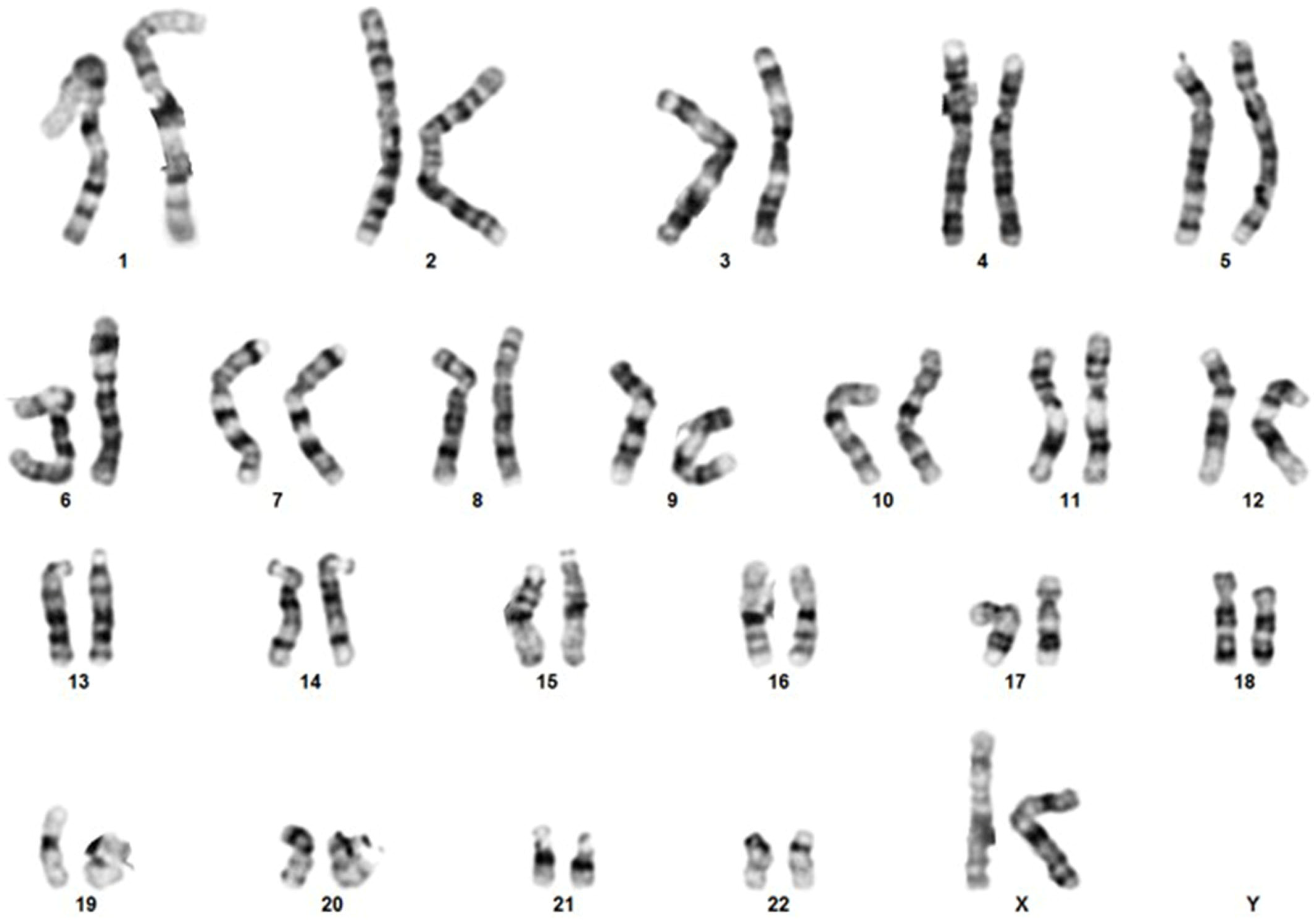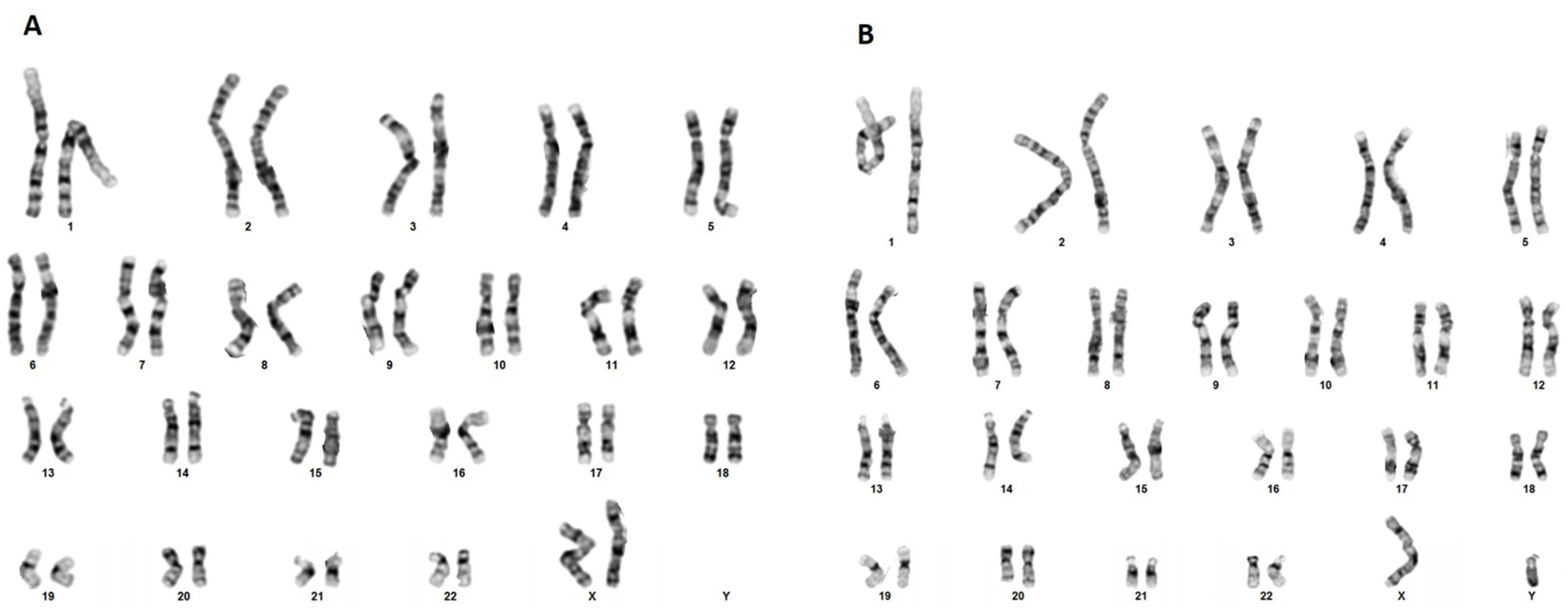A Case of Class I 17p13.3 Microduplication Syndrome with Unilateral Hearing Loss
Abstract
1. Introduction
2. Clinical Report
3. Cytogenetic and Molecular Studies
4. Discussion
Author Contributions
Funding
Institutional Review Board Statement
Informed Consent Statement
Data Availability Statement
Conflicts of Interest
References
- Blazejewski, S.M.; Bennison, S.A.; Smith, T.H.; Toyo-oka, K. Neurodevelopmental Genetic Diseases Associated with Microdeletions and Microduplications of Chromosome 17p13.3. Front. Genet. 2018, 9, 1–18. [Google Scholar] [CrossRef] [PubMed]
- Chen, C.P.; Chang, T.Y.; Guo, W.Y.; Wu, P.C.; Wang, L.K.; Chern, S.R.; Wu, P.S.; Su, J.W.; Chen, Y.T.; Chen, L.F.; et al. Chromosome 17p13.3 deletion syndrome: aCGH characterization, prenatal findings and diagnosis, and literature review. Gene 2013, 532, 152–159. [Google Scholar] [CrossRef] [PubMed]
- Bruno, D.L.; Anderlid, B.-M.; Lindstrand, A.; van Ravenswaaij-Arts, C.; Ganesamoorthy, D.; Lundin, J.; Martin, C.L.; Douglas, J.; Nowak, C.; Adam, M.P.; et al. Further molecular and clinical delineation of co-locating 17p13.3 microdeletions and microduplications that show distinctive phenotypes. J. Med Genet. 2010, 47, 299–311. [Google Scholar] [CrossRef] [PubMed]
- Armour, C.M.; E Bulman, D.; Jarinova, O.; Rogers, R.C.; Clarkson, K.B.; DuPont, B.R.; Dwivedi, A.; O Bartel, F.; McDonell, L.; E Schwartz, C.; et al. 17p13.3 microduplications are associated with split-hand/foot malformation and long-bone deficiency (SHFLD). Eur. J. Hum. Genet. 2011, 19, 1144–1151. [Google Scholar] [CrossRef] [PubMed]
- Curry, C.J.; Rosenfeld, J.A.; Grant, E.; Gripp, K.W.; Anderson, C.; Aylsworth, A.S.; Ben Saad, T.; Chizhikov, V.V.; Dybose, G.; Fagerberg, C.; et al. The duplication 17p13.3 phenotype: Analysis of 21 families delineates developmental, behavioral and brain abnormalities, and rare variant phenotypes. Am. J. Med Genet. Part A 2013, 161A, 1833–1852. [Google Scholar] [CrossRef] [PubMed]
- Roos, L.; E Jonch, A.; Kjaergaard, S.; Taudorf, K.; Simonsen, H.; Hamborg-Petersen, B.; Brondum-Nielsen, K.; Kirchhoff, M. A new microduplication syndrome encompassing the region of the Miller-Dieker (17p13 deletion) syndrome. J. Med Genet. 2009, 46, 703–710. [Google Scholar] [CrossRef] [PubMed]
- Hyon, C.; Marlin, S.; Chantot-Bastaraud, S.; Mabboux, P.; Beaujard, M.-P.; Al Ageeli, E.; Vazquez, M.-P.; Picard, A.; Siffroi, J.-P.; Portnoï, M.-F. A new 17p13.3 microduplication including the PAFAH1B1 and YWHAE genes resulting from an unbalanced X;17 translocation. Eur. J. Med Genet. 2011, 54, 287–291. [Google Scholar] [CrossRef] [PubMed]
- Bi, W.; Sapir, T.; A Shchelochkov, O.; Zhang, F.; A Withers, M.; Hunter, J.V.; Levy, T.; Shinder, V.; A Peiffer, D.; Gunderson, K.L.; et al. Increased LIS1 expression affects human and mouse brain development. Nat. Genet. 2009, 41, 168–177. [Google Scholar] [CrossRef] [PubMed]
- Liu, X.; Bennison, S.A.; Robinson, L.; Toyo-Oka, K. Responsible Genes for Neuronal Migration in the Chromosome 17p13.3: Beyond Pafah1b1(Lis1), Crk and Ywhae(14-3-3ε). Brain Sci. 2021; 12, 56. [Google Scholar] [CrossRef]
- Zhang, Y.-L.; Jing, X.-Y.; Zhen, L.; Pan, M.; Han, J.; Li, D.-Z. Prenatal diagnosis of Miller-Dieker syndrome/PAFAH1B1-related lissencephaly: Ultrasonography and genetically investigative results. Eur. J. Obstet. Gynecol. Reprod. Biol. 2022, 274, 28–32. [Google Scholar] [CrossRef] [PubMed]
- Capra, V.; Mirabelli-Badenier, M.; Stagnaro, M.; Rossi, A.; Tassano, E.; Gimelli, S.; Gimelli, G. Identification of a rare 17p13.3 duplication including the BHLHA9 and YWHAEgenes in a family with developmental delay and behavioural problems. BMC Med Genet. 2012, 13, 93. [Google Scholar] [CrossRef]
- Da Silva, J.D.; Gonzaga, D.; Barreta, A.; Correia, H.; Fortuna, A.M.; Soares, A.R.; Tkachenko, N. Refining the Clinical Spectrum of the 17p13.3 Microduplication Syndrome: Case-Report of a Familial Small Microduplication. Biomedicines 2022, 10, 3078. [Google Scholar] [CrossRef]
- Glans, M.R.; Thelin, N.; Humble, M.B.; Elwin, M.; Bejerot, S. The Relationship Between Generalised Joint Hypermobility and Autism Spectrum Disorder in Adults: A Large, Cross-Sectional, Case Control Comparison. Front. Psychiatry 2022, 12, 803334. [Google Scholar] [CrossRef]
- Rosenberg, C.; Freitas, É.L.; Uehara, D.T.; Auricchio, M.T.B.M.; Costa, S.S.; Oiticica, J.; Silva, A.G.; Krepischi, A.C.; Mingroni-Netto, R.C. Genomic copy number alterations in non-syndromic hearing loss. Clin. Genet. 2016, 89, 473–477. [Google Scholar] [CrossRef] [PubMed]
- Sloan-Heggen, C.M.; Babanejad, M.; Beheshtian, M.; Simpson, A.C.; Booth, K.T.; Ardalani, F.; Frees, K.L.; Mohseni, M.; Mozafari, R.; Mehrjoo, Z.; et al. Characterising the spectrum of autosomal recessive hereditary hearing loss in Iran. J. Med Genet. 2015, 52, 823–829. [Google Scholar] [CrossRef] [PubMed]
- Calkoen, E.V.B.; Merkus, P.; Goverts, S.; van de Kamp, J.; Mulder, M.; Aliaga, E.S.; Hensen, E. Evaluation of the outcome of CT and MR imaging in pediatric patients with bilateral sensorineural hearing loss. Int. J. Pediatr. Otorhinolaryngol. 2018, 108, 180–185. [Google Scholar] [CrossRef] [PubMed]
- Liao, E.N.; Li, Y.; Fung, A.; Lawless, L.; Czechowicz, J.; Ho, M.; Luu, K.; Meyer, L.; Mohamad, N.I.; Nadaraja, G.S.; et al. Predictors of successful natural sleep MRI for sensorineural hearing loss in infants. Int. J. Pediatr. Otorhinolaryngol. 2023, 165, 111430. [Google Scholar] [CrossRef] [PubMed]





| Somatometric Parameters | Percentile | |
| At birth | ||
| Weight | 2379 g | <3rd |
| Height | 45 cm | <3rd |
| Head circumference | 32 cm | 5th < p < 15th |
| At examination (4 years old) | ||
| Weight | 13 Kg | 5th < p < 15th |
| Height | 96 cm | 5th < p < 15th |
| Head circumference | 47.5 cm | 5th < p < 15th |
| Clinical findings | ||
| At birth—infancy | ||
| Abnormal automated otoacoustic emissions | ||
| Hypotonia | ||
| Delayed psychomotor development | ||
| At examination (4 years old) | ||
| Poor gross motor skills | ||
| Mild dysmorphic features (flattened midface, flat nasal bridge, and pes planus) | ||
| Generalized hypotonia and joint hypermobility | ||
| Hypermetropia | ||
| Left-sided sensorineural hearing loss | ||
Disclaimer/Publisher’s Note: The statements, opinions and data contained in all publications are solely those of the individual author(s) and contributor(s) and not of MDPI and/or the editor(s). MDPI and/or the editor(s) disclaim responsibility for any injury to people or property resulting from any ideas, methods, instructions or products referred to in the content. |
© 2023 by the authors. Licensee MDPI, Basel, Switzerland. This article is an open access article distributed under the terms and conditions of the Creative Commons Attribution (CC BY) license (https://creativecommons.org/licenses/by/4.0/).
Share and Cite
Vittas, S.; Bisba, M.; Christopoulou, G.; Apostolakopoulou, L.; Pons, R.; Constantoulakis, P. A Case of Class I 17p13.3 Microduplication Syndrome with Unilateral Hearing Loss. Genes 2023, 14, 1333. https://doi.org/10.3390/genes14071333
Vittas S, Bisba M, Christopoulou G, Apostolakopoulou L, Pons R, Constantoulakis P. A Case of Class I 17p13.3 Microduplication Syndrome with Unilateral Hearing Loss. Genes. 2023; 14(7):1333. https://doi.org/10.3390/genes14071333
Chicago/Turabian StyleVittas, Spiros, Maria Bisba, Georgia Christopoulou, Loukia Apostolakopoulou, Roser Pons, and Pantelis Constantoulakis. 2023. "A Case of Class I 17p13.3 Microduplication Syndrome with Unilateral Hearing Loss" Genes 14, no. 7: 1333. https://doi.org/10.3390/genes14071333
APA StyleVittas, S., Bisba, M., Christopoulou, G., Apostolakopoulou, L., Pons, R., & Constantoulakis, P. (2023). A Case of Class I 17p13.3 Microduplication Syndrome with Unilateral Hearing Loss. Genes, 14(7), 1333. https://doi.org/10.3390/genes14071333






